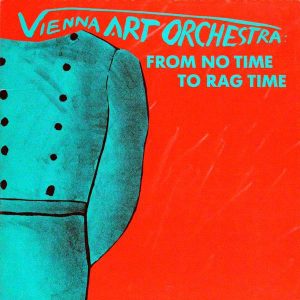
The Vienna Art Orchestra was a phenomenal ensemble led by saxophonist, arranger and composer Mathias Ruegg. The original lineup changed over the years, eventually to form a group made up of a jazz big band, with added percussion and woodwind instruments found in the symphonic orchestra. From No Time To Rag Time was the first record I ever heard of them, and right away my first impression was that it is highly virtuosic and advanced music. I was amazed by the level of musicianship from all the players, the complexity of the solos and the interesting orchestration and arrangements.
The opening track, titled Variations about n 508-10 (4g) is a quirky cacophony of sounds that tips the hat on different genres. The piece opens with a fast and complicated line featuring a soprano singer, a xylophone and a woodwind instrument (possibly a clarinet) all playing in unison. The opening phrase leads to a more straightforward section that starts with a canon played by the oboe (imitating a typical jazz walking bass line) then the vocalist enters, and then the trumpet plays a short solo while the percussion provides a steady swing beat. The band goes back to the opening phrase and again is followed by the B section with the walking bass line and trumpet solo. It then repeats back to the first phrase, but this time the drum set plays hits and fills that come unexpectedly, bringing in the band to a chaotic section with a lot of playing by various instruments in full swing mode. Suddenly, the band stops and the piano plays a complex and lengthy solo, with heavy dissonances throughout. After the piano solo the band comes in again, and the saxophone takes the next solo while the ensemble provides support. The piece ends with the vocalist and the trumpet trading lines. We can recognize the influence of jazz and the sound of the swing big bands flirting with classical music, postmodernism aesthetics, atonality and free jazz.
The next track is a slower, cool jazzy tune called Variations About Keep Your Heart Right. 5 of the 8 tracks in this album have the word “Variations” in it, which makes me wonder if indeed they are variations on previous compositions either by the bandleader or by other composers. The saxophones are featured predominantly and there are also memorable vocal lines in unison with the band. After the first dual saxophone solos, the band returns to the opening theme but then shifts gears to a faster tempo, setting up the mood for a cool trombone solo. Following the t-bone comes another saxophone solo, this time longer and without accompaniment, and then the big band kicks in at the same bright tempo as before. Finally, the coda has ensemble hits that are punched by the drum set and has an interesting blend of the different ensemble sections and timbres of the orchestra.
The 3rd track, Variations About Silence, features the soprano, exploring more of the free jazz aesthetics are. Next, the tune Un Poco Loco has more of a latin feel, with lively beats using cowbells and latin percussion and horn lines that have swing phrasing but also a bit of a Spanish flavor. The whole piece is played with a steady upbeat tempo, which is a nice break from the mostly swung rhythm of the previous tracks.
As with many jazz records, this album includes a lyrical jazz ballad called Variations About a Liberate Proposal. The drummer plays with brushes and adds nice effects on the cymbals while the percussionist enhances the tune with different effects using an array of instruments, including gongs, bells, chimes, jingles, maracas and other toys. But the saxophone is the main protagonist here, playing the main themes and lengthy solos while the band lays down the accompaniment. At the very end, the tempo is sped up and the piece ends with complicated phrases played by the saxophone and sung by the soprano in unison, a common trait used throughout the album.
From No Time To Rag Time is an interesting blend of contrasting schools and genres that in my opinion works well in exploring something new, sort of like the Third Stream concept does. This is a record that takes time to digest and thoroughly appreciate its nuances. It is a great piece of art and certainly one of my favorite big band crossover experiments.

